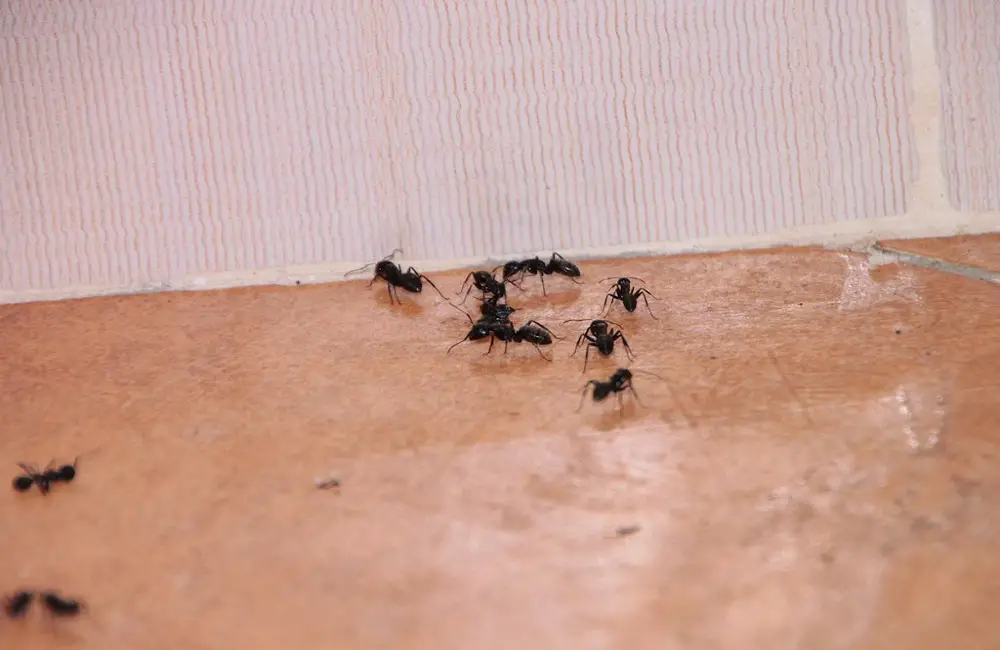They can be in your house in search of water, food, or refuge. Ants are something you do not want in your home, for whatever reason. It’s one thing to admire their teamwork and commitment, but quite another to have them march across your living room or kitchen.
These hardworking, nocturnal critters seem to materialize out of thin air, leaving behind unwanted tracks as they search for moisture and crumbs. If you have an ant infestation, you need to find a speedy solution.
Thankfully, there are methods for saying goodbye to these unwanted visitors. Let’s investigate the efficient methods for eliminating ants from your home.
What Are The Most Common Ants In The House?
Let’s have a look at the types of ants that are most likely to be found in your home before we discuss how to get rid of them.
- Odorous House Ants:These ants are usually found in kitchens and other places where there is oily or sugary food. If you smash them, they release an unpleasant odor.
- Argentine Ants: These ants build enormous colonies and frequently lay their eggs close to sources of moisture, such the plumbing in bathrooms.
- Carpenter Ants: They can harm buildings and are frequently discovered in damp or decayed wood.
- Pavement Ants: These ants are often found in basements and along sidewalks, where they construct their nests in cracks in the pavement or foundation.
- Pharaoh Ants: These little yellow ants, who are notorious for being hard to manage, like warm, humid environments and can make their nests in baseboards or wall cavities.
- Acrobat Ants: Distinguished by their heart-shaped abdomen, these ants typically build their nests in moist or rotting wood. They occasionally occur indoors as well.
How To Get Rid Of Ants In The House
1. Seal Entry Points
Sealing up cracks and openings is your first line of protection against ants, as they usually enter your home through these means. Gaps around windows, doors, pipes, and wires entering the house are common access locations.
Use premium caulk or silicone sealant that is suitable for the material you’re sealing to close gaps and fissures. Additionally, fix any rips, holes, or gaps in your window screens.
To ensure a tight seal, add weather stripping to the edges of windows and doors. Additionally, seal off any gaps or fissures in the walls, siding, or foundation.
2. Remove Food Sources
As you are already aware, one of the main reasons ants attack homes is to find food. Ants eat almost everything that humans do, frequently scavenging leftover food pieces or crumbs, and they are especially drawn to sweets.
Therefore, clean up spills and crumbs very away, especially in the kitchen and eating rooms, to keep ants away. Additionally, store food in sealed containers, especially sweets like syrup and honey.
Kitchen appliances should be cleaned on a regular basis since food particles can collect behind and under them. Trash cans should be kept clean and garbage should be disposed of on a regular basis. As for the flooring, keep them spotless to prevent the buildup of crumbs.
Never keep your pet’s food out for too long if you have one. Also, to create a barrier that ants won’t pass, submerge pet food dishes in shallow dishes of soapy water.
Ants want water in addition to food, so be sure to quickly repair leaks and remove any standing water from around sinks, tubs, and other areas.
3. Sprinkle Diatomaceous Earth (DE)
This organic material is lethal to ants yet safe for people and animals to consume. Diatomaceous Earth dehydrates and kills insects by absorbing their oils and fats, including ants. Apply a thin, even coating of food-grade DE along ant trails and access points, paying particular attention to the places where the ants are most active.
Even if it’s harmless for people and animals, don’t breathe in the dust. Make sure you apply DE while wearing gloves and a mask.
4. Vinegar
This multipurpose, everyday home item repels ants because of its potent aroma and acidic qualities. Mix vinegar and water (1:1 ratio) in a spray bottle, then thoroughly spray the solution along ant trails, entry points, windowsills, doorways, and other spots where you will likely encounter ants.
In order to get rid of ant trails and smell markers, think about washing your surfaces with a vinegar solution as well. Their foraging and communication routines will be disturbed by this.
5. Try Baking Soda and Powdered Sugar
Since the ants will take the mixture back to their nest, where it will eventually harm the entire population, you can use this DIY ant killer to target an entire colony. But remember that even while it works, it works slowly.
In a small bowl or container, mix equal parts powdered sugar and baking soda. While the baking soda upsets their digestive systems, the sugar draws in ants. After making your mixture, put them in areas of your home where ants are active or coming in.
Please be patient as this solution might not work right away. Additionally, keep a close eye on the bait and replenish it as necessary.
6. Lemon Juice
Lemon juice works similarly to vinegar as an ant cure because of its strong aroma and acidic nature, which repels ants. Not only that, but d-limonene, which is present in lemons, is poisonous to ants. Juice a fresh lemon, combine it with water, and spray the mixture in ant-prone areas.
To keep ants away from locations that are prone to their activity, you can also scatter lemon peels or essential oils with citrus scents close to entry sites. Moreover, clean surfaces with a cleaner that contains lemon, particularly in the kitchen.
7. Essential Oils
Certain essential oils have potent aromas that ants find disagreeable, so using them will help ensure that your home is ant-free. Citrus oils, cinnamon, thyme, lemongrass, tea tree, lemon eucalyptus, and peppermint oils are all suitable choices.
Since overly concentrated essential oils might irritate your skin or mucous membranes, always remember to dilute them with water or a carrier oil (such coconut or vegetable oil).
8. Pepper
The potent smell of pepper, particularly cayenne or black pepper, can make it difficult for ants to follow scent trails and find food. Since ants primarily rely on their sense of smell to move, communicate, and locate food sources, this aids in their removal.
Ground black pepper should be sprinkled along ant routes and entry locations. Pepper can be used to create a barrier that will prevent ants from entering certain areas.
9. Detergent
Ants’ exoskeletons and ability to function are disrupted by detergents, which effectively eliminates them. The ant’s waxy covering is broken down by the detergent, which causes the ants to quickly lose moisture through their exoskeletons, eventually resulting in dehydration and death.
Use a spray bottle to mix a tiny amount of dishwashing liquid or laundry detergent with water, and then spritz the mixture directly onto anthills.
Additionally, use a detergent solution to clean surfaces or areas that ants frequently visit. By doing this, the pheromone trails they leave behind are eliminated, which makes it more difficult for other ants to follow and find food sources.
10. Salt
Another approach to deter ants is to deliberately scatter salt across the area to create an unfavorable habitat. The ants get extremely dehydrated as a result of salt absorbing moisture from their bodies.
Ants are deterred from crossing salt-filled areas by the disruption of their paths caused by salt. These industrious insects may, nevertheless, discover detours or devise plans to get over salt barriers.
11. Boiling
Do the ants in your home live in a nest or are they gathered in one area? Directly pour boiling water onto the anthill or into their route. The ants’ habitat will be destroyed and they will get burned by the water. To prevent burns, exercise caution when working with hot water.
Additionally, you run the risk of harming heat-sensitive materials like some kinds of carpet and flooring.
12. Boric Acid
After being exposed to boric acid for just three weeks, a complete ant colony can be destroyed. Blend boric acid with an ant-attracting bait (powdered sugar, honey, or syrup), then set the ant treatment where ants are usually found.
Boric acid can be harmful if consumed in excessive amounts, so use it carefully, especially in homes where children or pets are present.
13. Cornstarch
Get cornstarch if you plan to suffocate a large number of ants at once. Here’s how cornstarch can be used to kill ants.
- Dredge the entire ant cluster in a generous layer of cornstarch, then douse with water. This will produce a lot of dead ants covered in cornstarch, which will make cleanup easier afterwards.
- As an alternative, dust the ants with cornstarch, vacuum them up, and discard the packed vacuum bag.
14. Commercial Ant Bait
Place stations with gel, liquid, or solid baits where ants frequently congregate. Usually, these baits are a combination of slow-acting insecticides and attractants, which the ants bring back to their colony and use to destroy the pest ultimately.
15. Ant Spray
Use an ant spray to target ants directly; it works quickly and effectively. Make use of an indoor ant spray. But keep in mind that you shouldn’t use ant sprays near kids or pets.
16. Ant Trap
These gadgets draw in and trap ants, usually by luring them inside with bait or a lure. Ant traps can be stations, gels, or filled containers, among other shapes. In addition to baits, ant traps contain an adhesive material or a caustic agent that keeps the ants from escaping.
Conclusion
Ants are normally harmless, but they can be annoying to live with. Fortunately, there are lots of simple and efficient ways to get rid of them, so you don’t have to. Combining techniques like sealing entry points, using baits, and maintaining a clean home results in a more all-encompassing ant management strategy.

